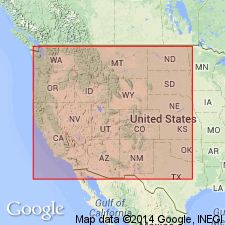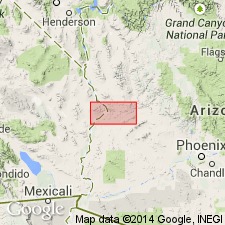
- Usage in publication:
-
- fanglomerate of Osborne Wash*
- Modifications:
-
- Geochronologic dating
- AAPG geologic province:
-
- Basin-and-Range province
Summary:
Pg. 6, geologic time scale (inside front cover). fanglomerate of Osborne Wash. Sample from "Headgate Rock" olivine basalt, lower basalt in fanglomerate of Osborne Wash, in NE/4 sec. 31, T. 10 N., R. 20 W., Lat. 34 deg. 10 min. 00 sec. N., Long. 114 deg. 16 min. 30 sec. W., Parker quadrangle, Yuma County, Arizona, yielded a K-Ar age of 12.9 +/-0.6 Ma (whole-rock), minimum age of extrusion. Sample from olivine basalt, in upper flow in fanglomerate of Osborne Wash, at Lat. 34 deg. 11 min. 00 sec. N., Long. 114 deg. 13 min. 30 sec. W., in NW/4 sec. 27, T. 10 N., R. 19 W., Cross Roads quadrangle, Yuma County, Arizona, yielded a K-Ar age of 8.5 +/-0.2 Ma (whole-rock), minimum age of extrusion. Ages calculated using decay constants of Steiger and Jager, 1977 (Earth Planet. Sci. Letters, v. 36, p. 359-362). [Miocene, based on time scale of Berggren, 1972, Lethaia, v. 5, no. 2, p. 195-215.]
Source: Publication.

- Usage in publication:
-
- Osborne Wash Formation
- Modifications:
-
- Named
- Dominant lithology:
-
- Fanglomerate
- Basalt
- Agglomerate
- Tuff
- AAPG geologic province:
-
- Basin-and-Range province
- Mojave basin
Summary:
Pg. 119, 122. Osborne Wash Formation. Consists of basal fanglomerates, basalt flows interbedded with agglomerate, tuff, and alluvial fan deposits; intrusive dikes and plugs. Thickness is greater than 400 m. Basal fanglomerates and air-fall tuffs have filled old valleys with relief of at least 300 m; unit deposited after detachment faulting. Unconformably overlies the Gene Canyon and Copper Basin Formations and older crystalline rocks. Age is Miocene to Pliocene(?).
Type locality not stated. Widespread exposures in western Buckskin Mountains, Yuma Co., AZ, and in southeastern Whipple Mountains, San Bernardino Co., CA. Origin of name not stated by authors, but probably named from exposures in hills near Osborne Wash, where AZ Highway 95 bridges the wash northeast of Parker, Yuma Co., AZ.
Source: US geologic names lexicon (USGS Bull. 1564, p. 122); supplemental information from GNU records (USGS DDS-6; Menlo GNULEX).
For more information, please contact Nancy Stamm, Geologic Names Committee Secretary.
Asterisk (*) indicates published by U.S. Geological Survey authors.
"No current usage" (†) implies that a name has been abandoned or has fallen into disuse. Former usage and, if known, replacement name given in parentheses ( ).
Slash (/) indicates name conflicts with nomenclatural guidelines (CSN, 1933; ACSN, 1961, 1970; NACSN, 1983, 2005, 2021). May be explained within brackets ([ ]).

